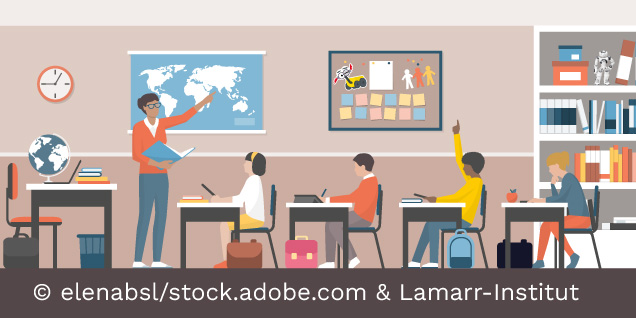
Experts agree that earlier encouragement in the STEM subjects is important.
Last year, the IBQ Education Trend revealed that fewer and fewer fourth-graders are meeting the minimum standards. In mathematics, more than one in five children (22 percent) fail to meet this standard. In some states, it is even every third child, such as in Berlin (34.5 percent). And in state of North Rhine-Westphalia, too, the figure is alarming at 28.1 percent.
This is where the initiative “Roberta® – Learning with Robots” of the Fraunhofer Institute for Intelligent Analysis and Information Systems IAIS comes in. Its goal is to get children interested in programming, robotics and AI. It’s not just about using digital offerings, but above all about acquiring basic digital skills and understanding technology. This knowledge is essential – whether for the professional world of today or tomorrow, or for the everyday lives of the younger generation.
Roberta began as a project funded by the German Federal Ministry of Education and Research and has since developed into one of the largest STEM education initiatives in Germany. In more than 20 years, Fraunhofer IAIS has trained around 5,000 teachers as Roberta-Teachers and reached more than 650,000 children.

© Fraunhofer IAIS
One of the secrets of the initiative’s success is the children’s sense of achievement. When they manage to let the robot drive and then avoid an obstacle, for example, it shows that anyone can learn to program. Such experiences of success strengthen self-confidence and increase learning success.
Motivation and fun are the first important steps. By using robots, students understand the meaning and purpose of algorithms. Complex contexts can thus be taught and learned better and more sustainably.
Roberta® – promoting digital education without boundaries
The most important features and goals of the Roberta initiative are:
- Gender equity: The initiative places particular emphasis on getting girls excited about STEM subjects and awakening their interest in technology and computer science.
- Practical and project-oriented approach: Students actively work with robots and learn how to program and control them.
- Teacher training: Roberta provides training and workshops to teachers so that they gain the knowledge and skills necessary to integrate robotics and programming activities into the classroom.
- Broad application: The initiative is not limited to specific age groups or school types, but can be used in elementary schools, secondary schools, and even non-school educational institutions.
- Own programming environment: Open Roberta is a web-based online programming platform. It offers students the opportunity to learn how to program robots and other hardware systems in a fun and interactive way. The open-source platform was developed specifically for use in education to support STEM classes and minimize the barriers to using programming, robotics and AI in schools.
The success of the Roberta initiative lies in its innovative and hands-on approach, which stimulates interest in STEM subjects among schoolchildren and at the same time empowers teachers to teach these subjects in an exciting and vivid way. By promoting STEM skills, the Roberta initiative aims to help get young people (girls as well as boys) excited about technical and scientific careers and thus also counteract the shortage of skilled professionals in these fields.
There is a great need for action in the STEM subjects. This is shown not only by a lack of teachers and the untapped potential of digitization, but also by a look at the numbers in STEM degree programs. Although 38 percent of first-year students will have chosen a STEM course in 2021, dropout rates are high. According to IW Köln, the proportion was around 49 percent in 2021. One reason: insufficient school competencies.The basis must therefore already be laid in school. Children and young people should be able to participate in shaping digitization.
Learning with robots – but why?
Robots in particular offer an attractive approach to computer science for children and young people. Robots also offer the opportunity to teach interdisciplinary topics.
- Technology and engineering: Robots are complex technical artifacts based on engineering principles. By working with robots, young people can learn about fundamental concepts such as mechanics, electronics, control systems and materials science.
- Computer Science and Programming: Knowledge of computer science and logic is necessary to program robots. Children and adolescents learn basic programming concepts such as instruction sequences, loops, and conditions when they, program robots to perform tasks. This promotes algorithmic thinking and the ability to solve complex problems.
- Mathematics: mathematical concepts such as coordinate systems, geometry, and trigonometry are used when programming robots. By applying mathematics in practice, for example when navigating a robot or calculating processes, young people can develop a stronger connection to mathematics – formulas take on a meaning.
- Natural sciences: Robots can be used as tools to explore scientific phenomena. For example, robots can be used to conduct experiments in physics, chemistry or biology. This enables young people to gain hands-on experience and apply and implement scientific principles themselves.
AI education with Open Roberta
Artificial intelligence (AI) as one of the most significant topics of our time is also a topic of the education initiative. AI already permeates many areas of our lives. If we want to deal with the topic in a confident manner, we need to bring the subject into schools at an early stage. The close ties with the Lamarr Institute as a leader in cutting-edge AI research are worth highlighting here. Since 2022, simple artificial neural networks (KNN) can also be programmed in the Open Roberta Lab. Open Roberta calls this xNN (for explainable neural networks). xNN offers students as young as 6th grade the opportunity to program simple neural networks themselves. Normally, KNNs are used as a kind of black box. For example, to unlock the smartphone via face or fingerprint recognition. The Open Roberta Lab offers the possibility to take a look into this black box and to learn the basics of neural networks in a playful way. In this way, students come into contact with the technology behind AI at an early stage. AI algorithms can be intuitively experienced and understood through graphical programming.

The artificial neural network receives its data from the sensors of a robot, processes them in the CNN it has programmed itself and returns the values to the robot, which interprets them, for example, as motor values. The students thus learn very quickly the influence of data on the neural network and thus also on the control of the robot. In addition, xNN also offers the possibility of training the neural network so that the robot avoids obstacles or follows a black line.
Why we need to encourage young people to get into coding, robotics and AI at an early age
Artificial intelligence and programming can no longer be seen in isolation from other subjects. If children and adolescents understand the basic processes in this field, it will help them not only in other science subjects, but also in everyday life. AI is here to stay. Children are curious to discover at first hand how AI can be used. But they should also know what’s underlying the technology and how algorithms work. This is also a way to counteract the ever-increasing shortage of skilled professionals. The Roberta initiative creates a connection to technology and computer science at an early stage, laying the basis for STEM education for our next generations. With the Lamarr Institute and its connection to research, the commitment pays off in sustainable excellence in research and can be a first step in the careers of tomorrow’s highly qualified scientists. Together, we empower young people to understand and actively shape the digital future.
Further Information
- The Roberta initiative: https://www.roberta-home.de/en
- The Open Roberta Lab: https://lab.open-roberta.org/
- Training & materials for teachers from elementary school to high school: https://www.roberta-home.de/en/teachers/
